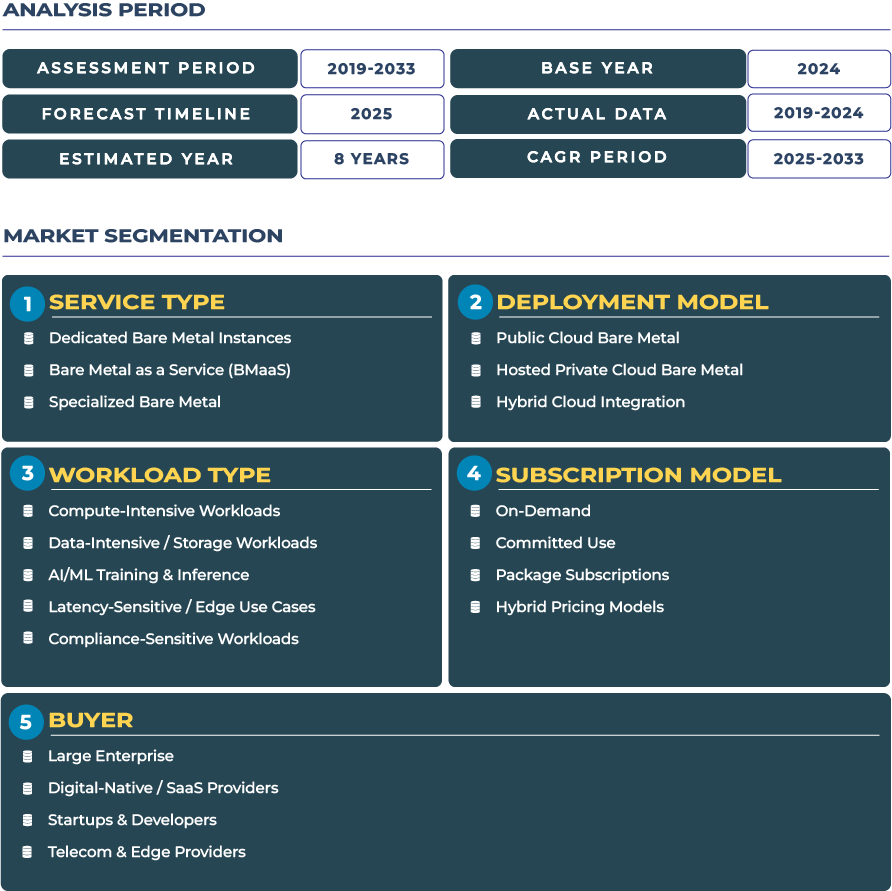Report Format:
![]()
![]() |
Pages: 110+
|
Pages: 110+
Argentina Cloud Bare Metal Market Outlook: Blockchain and HPC-Optimized Bare Metal Driving the Strategic Compute Imperative
Argentina is emerging as a testbed for blockchain-ready, HPC-optimized bare metal infrastructure anchored in local sovereignty and compute autonomy. In this landscape, the Argentina cloud bare metal ecosystem must support deterministic performance, custom hardware stacks, and heavy workloads tied to financial systems, research computing, and Web3 initiatives. Local enterprises involved in fintech, crypto exchanges, simulation labs, and data-intensive analytics require bare metal with low-latency access, control over firmware, and compliance with local regulations. In sum, bare metal is not a niche in Argentina-it is becoming a platform for strategic compute independence and vertical innovation.
Projections indicate that the Argentina cloud bare metal market will rise from approximately USD 125.4 million in 2025 to about USD 416.4 million by 2033, corresponding to a CAGR of around 16.2 %. This growth is driven by rising AI, analytics, and blockchain workloads that demand dedicated performance, and by local enterprises’ preference to retain data and compute within national boundaries. Argentina has roughly 34 to 42 data centers across multiple metro areas. In Buenos Aires alone, there are about 15 active data centers operated by multiple providers, including carrier-neutral facilities like EdgeConneX and telecom-centric sites . Facilities like IFX Tier III data center in the Belgrano district represent the kind of infrastructure base upon which bare metal operations can be built reliably . As Argentina intensifies digital infrastructure investments and regulatory incentives, bare metal services will be increasingly integrated into enterprise compute strategies.
Drivers & Restraints: Underlying Forces Shaping Argentina Bare Metal Adoption
Driver: Predictable Licensing & High-Volume Analytics Demands
One of Argentina strong incentives for bare metal adoption is predictable software licensing models tied to physical cores or hardware attributes. Many enterprise platforms and legacy systems are licensed per CPU socket or per physical core, making bare metal preferable over shared virtual environments. Beyond that, data-intensive analytics, simulation, scientific computing, and blockchain ledger operations create demand for IOPS consistency, deterministic latency, and raw throughput-characteristics better served by bare metal infrastructure. For organizations in research, finance, biotech, or telecom, the compute headroom and isolation offered by bare metal is critical to performance and stability.
Restraint: Limited Data Center Footprint & Elevated Operational Overhead
Despite attractive demand, Argentina faces limiting factors. First, the geographic data center footprint is concentrated, especially in Buenos Aires and a few provincial hubs. This limits coverage and imposes latency constraints for more remote regions. Second, operational overhead and administrative burden for bare metal is higher than for abstracted cloud: providers and customers must manage hardware lifecycle, firmware updates, support, redundancy, power and cooling design, and failover design. For businesses used to managed cloud services, that friction can deter bare metal adoption-especially for smaller or mid-market players. These restraints slow broader adoption until infrastructure scale, managed service support, and automation maturity improve.
Trends & Opportunities: Emerging Patterns in the Argentina Bare Metal Domain
Trend: Growing Adoption of High-Performance Storage on Bare Metal & CDN Integration
A notable trend is embedding high-performance storage (NVMe, ultra-fast I/O stacks, persistent memory) directly on bare metal nodes to support databases, streaming pipelines, caching layers, and content delivery. By co-locating compute and storage with minimal abstraction, enterprises can drive lower latency and higher throughput for demanding workloads. Also, integration with CDNs and media delivery paths is rising: bare metal servers located close to user access points can serve as media caches, edge compute nodes, or dynamic proxy layers, reducing load on backbone links and improving end-user experience.
Opportunity: Tailored Solutions for Blockchain / Web3 & Underserved Provincial Markets
One compelling opportunity lies in offering tailored bare-metal environments optimized for blockchain or Web3 workloads, including configurations with GPU/FPGA, low-latency networking, and on-chain node acceleration. These offerings can attract startups, exchanges, or permissioned ledger deployments seeking local, performant infrastructure. Another opportunity sits in expanding into underserved provincial markets outside Buenos Aires-cities such as Córdoba, Rosario, Mendoza can host localized bare-metal nodes and reduce latency for regional clients. As data center maps show, these regions are underrepresented in current footprint. Providers that move first into these markets gain strategic footprint advantage.
Competitive Landscape: Local Players, Infrastructure Moves & Pricing Innovation Strategies
In Argentina, the infrastructure ecosystem is dominated by data center operators, telecom groups, and regional colocation providers. Telecom Argentina operates the Pacheco / EZE1 data center, a key facility in the Buenos Aires metro area. EdgeConneX also established a multi-tenant facility in Buenos Aires, enhancing carrier-neutral connectivity. Local operators like InterBS and CABASE also host infrastructure and IX nodes. In the global domain, providers like HostDime operate bare metal and hosting infrastructure across Latin America including Argentina markets. Competitive strategies to win market share include pricing innovation, hybrid bundling, and regional expansion into secondary cities. Services that reduce entry friction-API provisioning, automated deployment, remote hands, monitoring dashboards-will distinguish leaders in the Argentina cloud bare metal landscape.







